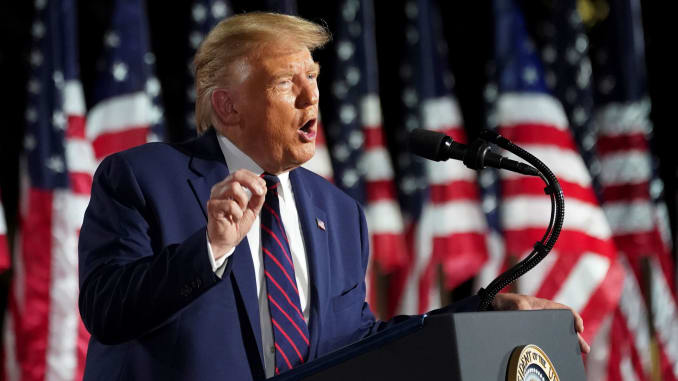
By Evan Madden|| Contributing Writer
On Thursday, a maskless crowd stood on the South Lawn of the White House chanting “four more years,” as incumbent President Donald Trump stepped up to the podium to accept his Republican nomination for the 2020 election. Following a previous venue change from Charlotte, North Carolina to Jacksonville, Florida after a surge in Covid-19 cases, Republicans made the controversial decision to bring the RNC to Washington, raising concerns about the illegality of using federal employees for campaigning. Despite opposition, Trump accepted his nomination at the nation’s capital.
Trump’s hour-long speech gave few surprises despite its controversial backdrop, with the President repeating many appeals to his mostly white conservative Christian base, such as his immigration policy, pro-gun stance, and demand for “law and order” copied straight from the Nixon campaign. Trump vowed not to “give free rein to violent anarchists and agitators and criminals who threaten our citizens,” referring to recent protests against police violence led by the Black Lives Matter Movement.
The latest wave of protests in Kenosha, Wisconsin following the non-fatal shooting of Jacob Blake, a 29-year-old African American man, went unmentioned save for the city’s mention alongside other “Democrat-run cities” that have experienced violence. Trump stoked fears by warning that “left-wing anarchy” would only worsen with a Democrat in the White House.
Trump attempted to appeal to African American voters with the bold claim, “I say very modestly that I have done more for the African American community than any president since Abraham Lincoln, our first Republican president.” He cited record-low African-American, Hispanic, and Asian-American unemployment rates before the Coronavirus pandemic to support this claim, though inequality persisted as minorities still saw much higher unemployment rates than whites.
Trump gave a scathing rebuke of his Democratic opponent Joe Biden’s political record, stance on law enforcement, and plan for reopening America, warning Americans that, “Joe Biden is not the savior of America’s soul—he is the destroyer of America’s jobs, and if given the chance, he will be the destroyer of American greatness.” Despite Biden’s mostly moderate political leanings, Trump was quick to label Biden’s agenda as socialist. He also claimed Biden would defund police departments nationwide, despite Biden publicly opposing the policy.
The president applauded the response of federal and local officials in the wake of Hurricane Laura, mentioning his tours of the storm damage in Louisiana and Texas this past weekend. He continued by promising a Covid-19 vaccine by the end of the year or sooner, as well as “a return to full employment, soaring incomes and record prosperity” in his second term. Amid criticism of the President’s response to the pandemic and uncertainty concerning the full scope of its economic impact, Trump was optimistic that he could restore normalcy and job growth.
He held up the United States’ withdrawal from the Trans-Pacific Partnership, Iran nuclear deal, and the Paris Climate accords as examples of the foreign policy of putting “America first” by walking back global agreements. He also presented the updated USMCA trade deal with Mexico and Canada, a slight rework of NAFTA, as an example of his ability to negotiate better deals for America. He touted the 300 miles of barriers added to the border, though they were not paid for by Mexico as originally promised.
Trump presented the 2020 election as a clear choice of “whether we save the American dream or allow a socialist agenda,” echoing a narrative repeated throughout the convention regarding Democrats’ supposed plans for increased government regulation of the economy and a more empowered federal government call for socialism.
With November quickly approaching, we have yet to see if the choice before Americans will be as clear cut as Donald Trump presents it. Biden has maintained a slight lead in national polls, but Trump managed a narrow victory in 2016 with polls favoring his opponent Hillary Clinton. Trump’s ability to register with swing voters will determine whether he can keep the presidency.
First Year Evan Madden is a Contributing Writer. His email is emadden1@fandm.edu.